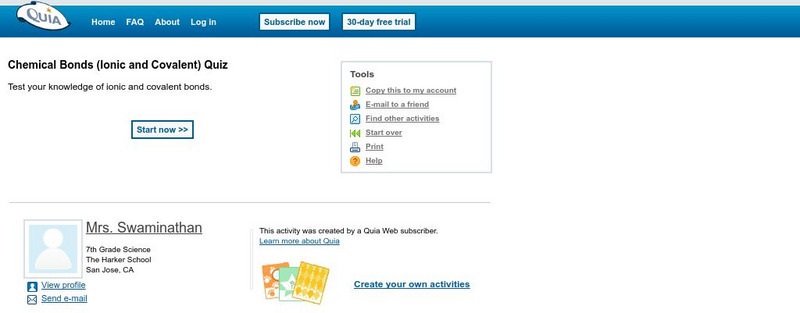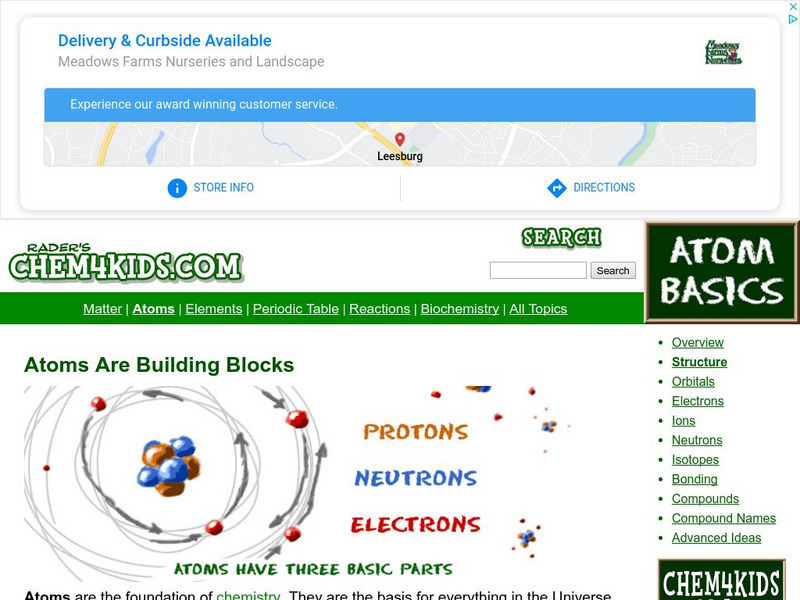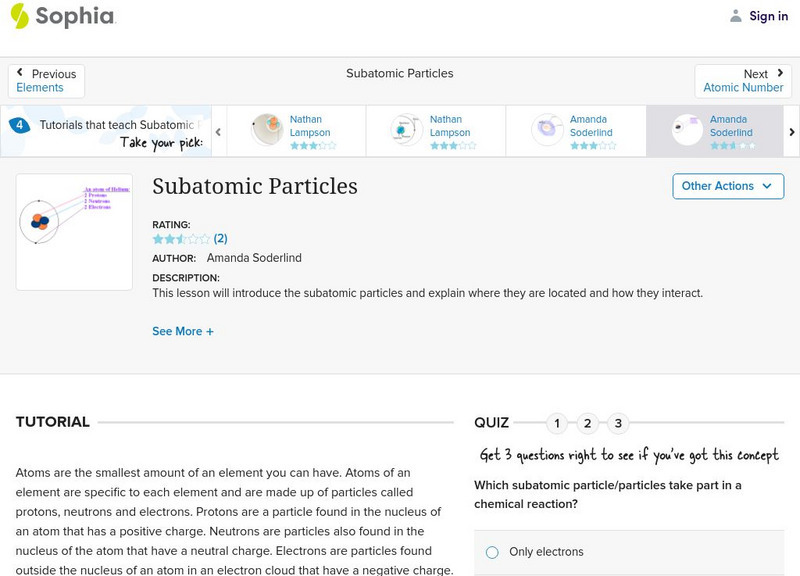Museum of Science
The Atoms Family: Spectroscope of an Atom
"The Phantom has provided you with a simulated spectroscopy of an Atom! Amuse the Phantom by observing the spectroscope and you'll learn more about the Atom." Observe and review the structure of the atom.
Quia
Quia: Chemical Bonds (Ionic and Covalent) Quiz
This is 21-question multiple choice quiz over chemical bonds was written for a 7th-grade science class.
Chem4kids
Chem4 Kids: Atoms Are Building Blocks
Identify the basic structure of atoms, the building blocks for all matter.
Physics Classroom
The Physics Classroom: Static Electricity: Neutral vs. Charged Objects
With this interactive tutorial, students explore the basic terminology and concepts of neutral and charged objects.
Khan Academy
Khan Academy: Charge Transfer Processes
In this 4-question quiz, predict how charge gets transferred by conduction between two objects.
Florida State University
Florida State University: Powers of Ten
This webpage from the Florida State University offers an applet with succeeding images, each "10 times bigger or smaller than the one preceding or following it," as a demonstration of exponential notation.
Thomas Jefferson National Accelerator Facility
Jefferson Lab: Beta Decay
This site from Jefferson Lab provides a description of beta decay along with two helpful formula examples. Several links are provided throughout this page for additional information on related subjects.
New York University
New York University: Law of Conservation of Energy
Site presents a straightforward presentation of Rutherford's work concerning the Law of Energy Conservation. Provides an adequate summary of early science on the nucleus, and includes much needed illustrations.
Sophia Learning
Sophia: Subatomic Particles: Lesson 3
This lesson will introduce the subatomic particles and explain where they are located and how they interact. It is 3 of 7 in the series titled "Subatomic Particles."
Sophia Learning
Sophia: Subatomic Particles: Lesson 4
This lesson will introduce the subatomic particles and explain where they are located and how they interact. It is 4 of 7 in the series titled "Subatomic Particles."
Sophia Learning
Sophia: Subatomic Particles: Lesson 6
This lesson will introduce the subatomic particles and explain where they are located and how they interact. It is 6 of 7 in the series titled "Subatomic Particles."
Sophia Learning
Sophia: Subatomic Particles: Lesson 7
This lesson will introduce the subatomic particles and explain where they are located and how they interact. It is 7 of 7 in the series titled "Subatomic Particles."
Sophia Learning
Sophia: Subatomic Particles: Lesson 5
Describe the difference between the subatomic particles, including their masses, locations, and charges. This lesson is 5 of 7 in the series titled "Subatomic Particles."
Sophia Learning
Sophia: Atoms: Lesson 3
This lesson will provide an understanding of the basic chemistry of atoms. It is 3 of 5 in the series titled "Atoms."
Sophia Learning
Sophia: Atoms: Lesson 4
This lesson will provide an understanding of the basic chemistry of atoms. It is 4 of 5 in the series titled "Atoms."
Sophia Learning
Sophia: Atoms: Lesson 5
This lesson will provide an understanding of the basic chemistry of atoms. It is 5 of 5 in the series titled "Atoms."
Sophia Learning
Sophia: Subatomic Particles: The Neutron: Lesson 2
This lesson will explain that neutrons are particles in the nucleus that have no charge and a mass of one amu. It is 2 of 3 in the series titled "Subatomic Particles: The Neutron."
ClassFlow
Class Flow: Atomic Structure: Parts of the Atom
[Free Registration/Login Required] This flipchart defines the parts of the atom. It uses Activotes for assessment.
Science4Fun
Science4 Fun: What Is Atom
Fun and interesting illustrated information on atoms including composition, elements, and history.
Curated OER
[Bohr Model of Unununium]
A look at the transition metal unununium, which was renamed roentgenium in 2004. Includes basic information, including symbol, number, mass, melting and boiling points, and numbers of protons, electron, and neutrons.
Curated OER
Science Kids: Science Images: Hydrogen Atom
This is a simple picture of a hydrogen atom using the Bohr model. A negatively charged electron can be seen on the outside of the positively charged proton.
Curated OER
Science Kids: Science Images: Basic Atom Structure
This diagram shows a basic atom structure with an atom core, proton, neutron and electron.
Exploratorium
Exploratorium: Remote Control Roller
Students can make a empty soda can roll with an electrically charged balloon.
Lawrence Berkeley National Laboratory
Berkeley Lab: Basic Nuclear Science Information
Site provides the ABC's of nuclear science including radioactivity and gamma decay to fission and comic rays.
Other popular searches
- Protons, Electrons, Neutrons
- Protons Electrons Neutrons
- Electrons, Neutrons, Protons
- Electrons and Protons
- Atoms Electrons Protons
- Protons Electrons Crossword
- Protons Electrons Neutorns
- Protons Electrons Scales

















